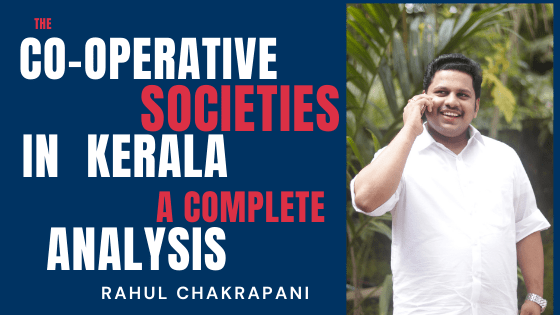The story of cooperative societies in Kerala e routes from an international renaissance period,
it was a reaction of people of our state reacts to the situation of the western world.
Rahul chakrapani can able to start the cooperative society story by mentioning the Greate Sahodaran AyyappanN Kerala
SAHODARAN AYYAPPAN; MASTER AS A SOCIAL REFORMER
Sahodaran Ayyappan was a social Reformer, Rationalist and politician associated with several events like Kerala reformation and organizer of Misra Bhojanam in Cherai in 1917.
He was the founder of Sahodara Sangam. He was the foremost figure who changed the face of Kerala.
Ayyappan Master was born on August 21, 1889, in Ernakulam.
He completed B.A. Lit from Maharajas college.
Even during his college days,
he voiced against the rights of the upper and lower class of people (suppression of weaker sections of society by upper class.
He was a follower of Narayana Guru and Started a magazine in 1928 titled Yukthivadi which was against superstition and casteism.
He launched the SahODARA sangham (Brotherhood Association) as a platform for young people who were interested in social change.
Misra Bhojanam(inter-dinning of upper castes and outcastes) initiated by Ayyappan master was not only opposed by upper-class people but also by certain Reformists.
This earned him the title “Pulayan Ayyappan”.
But this doesn’t stop him from his voluntary ideas.
He also coined a rejoinder Jati Venda, Matam Venda Manushyanu.
He was selected to Kochi Assembly in 1928 and worked as Public Minister in 1947.
He resigned his post when his government was harsh on lower-class people.
His extraordinary vision and mission reflect in many of his projects while serving as a Minister.
Ayyappan was married to Parvathy.
During his later stage of his life, Ayyappan regularly wrote articles on various topics for Vivekodayam magazine.
He died on March 6, 1968.
Now all his dreams based on society comes true.
WHAT IS AN COOPERATIVE SOCIETY?
Cooperative Society is a voluntary association of individuals having common needs who join hands for the achievement of common economic interest. It aims to serve the interests of the poor section of society through self-help and mutual help
According to Sir. Horace Plunkett’s Cooperation is self-help made effective for better farming, better business and better living.
Cooperative Society has emerged as a consequence of the industrial revolution and the proliferation of industrial activities.
TYPE OF COOPERATIVE SOCIETIES
There are six types of societies
1.Consumer Cooperative Societies
2.Producers Cooperative Societies
3.Cooperative Marketing Societies
4.Cooperative Housing Societies
5.Cooperative Credit Societies
6.Cooperative Farming Societies
There are 2 different classes.
They are industrialist and labourers.
The industrialist exploits labourer and weaker sections of people.
To protect the interest of weaker sections of society cooperative movement was formed.
Each for all and all for each and self-help through mutual aid is the motto of the cooperative movement.
Hence Cooperative movement was an awakening movement for farmers and peasants as agriculture and its allied activities,
it has immense potential to deliver goods and services where the government and private sector fail to reach.
Features
1.Voluntary Association
2.Equal Voting Rights
3.Service motive
4.Distribution of Surplus
5.State control
6.Elimination of middlemen
7.cash trading
8. Audit
9.Principle of self-help and mutual help
10.Democratic Management
11.Open membership
12. One man vote
13.Spirit of cooperation
14.Capital raising
15.Registration
15.Management of affairs of the cooperative
16.Dividedend distribution from surplus
17.Service motto
18.Fixed Return on capital
19.Common interest
20.Equality to vote
21.Distributive justice.
22.Limited capital
23.Principle of perpetual existence.
PRINCIPLES OF COOPERATIVE SOCIETY
The cooperative society is widespread and it includes money lending, marketing, consuming, housing, women’s welfare, educational, health and construction sectors.
The functioning of these institutions helps to provide the people of various kinds at low cost.
At present 14.000 cooperative societies are registered.
Of these 10,503 societies function satisfactorily.
Within short life span, the role of cooperative society extend beyond agriculture started covering activities like such as production, farming and processing meagre funds of farmers were pooled in to run cooperative society.
It is an attractive way to financial problems. After independence role of cooperative societies grew to encompass socio-economic development and eradication of poverty in rural India.
ROLE OF GOVERNMENT TO HELP FARMERS
The Government is intervening effectively to take the cooperative sector forward and extend its service to people. Loans up to Rs.2 lakhs of those farmers who committed suicide were written off. Remission of interest shall not exceed the Principal amount was implemented.
During the agricultural disaster rate of interest was reduced from 9 to 5.5. Interest-free loans for Promotion of paddy cultivation was implemented.
Collective farming is based on social ownership of production and collective labour.
Diary is an important source of income to small/marginal farmers. The manure of animals provides a source of organic matter for improving soil fertility and crop yields.
The biogas from the dung is used for running the engine for drawing water from wells.
Recently Kerala government made it clear that Kerala Government won’t follow the contract farming model that gives direct access to corporates into the corporates the state Government promotes collective farming which is done by various cooperatives and community networks like Kudhumbhashree.
ROLE OF COOPERATIVE BANK
The function of cooperative Bank is to provide loans to Primary cooperative society.
This empowers and secures the poor and the low-income groups.
1.Credit facilitates like Rural financing and micro-financing.
2.Offer credit to the common man at moderate interest rates, eliminating the dominance of private money lenders.
3.Provides agricultural loans to farmers at a low-interest rate.
4.Easy access to credit for rural industries.
5.Financial services in rural areas where banking facilities are scarce.
COOPERATIVE SOCIETY HELPS IN KERALA FARMER
1.Provides agricultural credit and funds where state and private sectors have not been able to do very much.
2.Provides strategic input for the agricultural sector, consumer societies meet their requirements at concessional rates.
3.Overcome the constraints of agricultural development.
History
History of co-operative society starts from Italy and we are looking at the history of India as well through our outlook
COOPERATIVE MOVEMENT IN ITALY:
The cooperative movement is much older than is generally known. The Cooperative Organization was formed in the Fifteenth Century in Northern Italy.
PRE-FASCIST COOPERATIVE MOVEMENT:
Pre fascist cooperative movement had two main wings.
Cooperative Socialist movement Central Organization was a National Cooperative League in Milan.
From a Geographical point of view, most cooperatives belonging to the League
were in Northern and Northeast Italy.
The League was divided into three sections Agricultural (centre in Bologna) Consumer (centre in Milan) and Productive and Labor (centre in Rome)
CATHOLIC MOVEMENT:
The Centre of Catholic movement was the Cooperative Federation in Italy.
The movement was connected with the people’s party and controlled by the Catholic church.
Importance was given in the field of agriculture.
WORKMEN’S PRODUCTIVE COOPERATIVE MOVEMENT:
Workmen’s Productive Cooperative Movement was the only outstanding cooperative movement in Italy.
The largest shipyard in Italy was controlled in 1919 by Workmen’s Productive Cooperative.
Workmen’s Productive Cooperative movement had a few federations of their own and enjoyed priorities from Government contracts.
CONSUMER COOPERATIVE MOVEMENT:
Consumer cooperative played a vital role in the life of Italian Peasants, Tenants farmers and Urban population.
In several districts’ villages depend entirely upon Consumer Cooperative for Bread, Meat, Groceries and in a lesser degree for fuel and clothing.
The largest consumer cooperations in Italy were in Milan (1918) and Turin.
It had 160 branches for clothes, boots, dairy products, Théâtre, libraries and universities.
The cooperative in Turin had 13,000 members,150 operated shops and over 1,000 employees.
In Rome since 1937, the entire milk supply was under cooperative management.
COOPERATIVE IN FASCIST ITALY :
In 1922 a temporary Central commission for cooperatives was organized by Fascist.
It was composed of 10 representatives of cooperation and 9 of them from the Government.
In 1937 the following organization belonged to the institution.
1.Cooperatives for production and Labor
2.Cooperatives for collective purchase and sale of agricultural requisite
3.Diary cooperatives
4.Wine making societies
5.Oil producing cooperatives
6.Cooperatives mills
7.Cooperativebuilding societies
8.Transport societies
COOPERATIVE MOVEMENT IN MODERN TIMES:
In Emilia Romagna, the people co-operate as they mean. To support economic development, every Co-operate in Italy by law contributes 3% of its annual surplus to a fund for co-operative development.
Co-op sectors Misran etc, are more integrated than in any parts of the world and work together through informal as well as formal relationships such as federations.
The social and financial capital built up by co-operators is considered the Patrimony not just for the current members, but of future generations as well.
For them, cooperation is a way of life and its benefits are quite visible.
COOPERATIVE MOVEMENT IN INDIA:
The cooperative movement in India divided into two phases.
1.Cooperative movement in the pre-Independence era
2.Cooperative movement in post-Independence
COOPERATIVE MOVEMENT IN PRE INDEPENDENCE:
Farmers of Pune and Ahmednagar encounter an agitation against money lenders for charging high-interest rates.
So the British Government passed 3 acts against money lenders
1.Deccan Agricultural Relief Act (1879)
2.Loan improvement Loan Act (1883)
3.Agricultural Loan Act (1884)
In 1993, Cooperative became a Provincial subject and the provinces authorized their own cooperative laws under Montague based on Chelmsford Reforms.
In 1942 the Government of British India enacted Multi-unit cooperative societies Act to cover Cooperative Societies with membership from more than one province.
COOPERATIVE MOVEMENT IN POST INDEPENDENCE ERA:
India’s First Prime Minister India’s Nehru had a strong faith in the Cooperative movement. Hence after independence, cooperation became an integral part of five-year plans.
- In 1958, the National Development Council (NDC) recommended a National policy on cooperatives and also for training personnel and setting of cooperative marketing societies.
- In 1984, Parliament enacted the Multi-State cooperatives societies Act to remove a Plethora of different laws governing the same type of societies.
3. White Revolution and the Green Revolution were introduced.
4. Government of India announced the National Policy on Cooperation.
- objectives of national policy: Providing support for promotion and development of cooperation. Reduction of regional imbalances and Strengthening of cooperative education, training and human resources development.
MAJOR PLAYERS IN COOERATIVEECTOR KERALA
KERALA COOPERATIVE MILK MARKETING FEDERATION;
KERALA STATE COOPERATIVE RUBBER MARKETING FEDERATION
KERALA KERA KARSHAKA SAHAKARANA FEDERATION LIMITED (KERAFED)
SC/ST COOPERATIVE SOCIETIES:
KERALA STATE HANDLOOM WEAVERS COOPERATIVE SOCIETY :(HANTEX)
COIR
CENTRAL ARECA NUT AND COCOA MARKETING AND PROCESSING COOPERATIVE LIMITED
KERALA STATE COOPERATIVE UNION
EMPLOYMENT ORIENTED COOPERATIVE
HANDICRAFTS APEX COOPERATIVE SOCIETY
KERALA COOPERATIVE MILK MARKETING FEDERATION;
Kerala cooperative milk marketing federation (KCMMF) or Milma was Registered as a cooperative Society in 1980 with its Head office in Thiruvananthapuram.
It was brought under the Operation Flood Programme of the National Dairy Development Board.
KCMMF is a Federations of three Regional Milk Unions.
The ERCMPU, TRCMPU and MRCMPU.KCMMF has a three-tier structure.
They are Primary milk cooperative societies, Regional milk Producers unions and Kerala cooperative milk Marketing Federation Limited.
Keeping pace with the development of milk Procurement and sale Milma has concentrated on infrastructural development with financial assistance from the National Dairy Development Board,
Swiss Development cooperation and others are 13 milk processing Plants with a capacity of 12.50 lakh per day and 8 Milk chilling plants scattered over the state.
The Kerala Cooperative Milk Marketing Federation has one of the successfully run cooperatives in Kerala.
Peoples strength is the main reason for the success story.
Kerala Cooperative Milk Marketing Federation is a testimony to the success of cooperative development in the hands of the people themselves.
KERALA STATE COOPERATIVE RUBBER MARKETING FEDERATION:
Kerala State Cooperative Rubber Marketing is the apex Organization of Rubber Marketing Societies was incorporated in 1971 with its headquarters in Ernakulam with 37 cooperative Rubber Marketing Societies, Rubber Board and Government of Kerala as members.
The main objectives of Rubber Marketing Federation are to protect the interest of rubber growers especially small growers in Kerala, the activities are marketing and export of natural rubber, distribution of fertilizers and agricultural inputs and processing of natural rubber and product manufacturing,
KERALA KERA KARSHAKA SAHAKARANA FEDERATION LIMITED (KERAFED)
KERAFED is an agency of integrated development of coconut through procurement, processing and marketing of coconut and its products.
One of its value graded product is KERAKESH.KERAFED follows an aggressive marketing strategy.
KERAFED network includes Triveni supermarket,
Triveni Coffee House,
Low budget hotels,
notebooks, Neethi gas,
Neethi store,
Neethi medical store,
Foreign liquor,
Triveni noon scheme and management.
In 1972 Federation was formed with 10 primary stores. Its main objectives are to distribute various consumer goods at a reasonable price through outlets named “Triveni’.
SC/ST COOPERATIVE SOCIETIES:
SC/ST cooperative was registered in 1981.
It aims to improve the socio-economic conditions of SC/ST communities.
There are four branches.
They are located in Trivandrum, Kothamangalam, Thrissur and This cooperative there are about 495 scheduled caste and 98 Scheduled Tribe societies.
Federation is running a petrol bank of Indian oil corporation, honey processing corporation, honey processing unit, manufacturing unit at Anchorite total sales turn over during 2003-04 is Rs,8.70 crores.
KERALA STATE HANDLOOM WEAVERS COOPERATIVE SOCIETY :(HANTEX)
Kerala State Handloom weavers were established in 1961 with 300 Primary society throughout the state.
The main objective is to support the handloom weavers of the state for production and marketing of quality Handloom products.
Weavers cooperative societies have an awesome collection of geographical indication tagged products more than 100 varieties sarees and matching Sets besides. They also have various kinds of furnishing, clothing, shirting, dhotis, bedsheet etc.
COIR
Coir is the most prominent traditional industries in Kerala.
It is the natural hard fibre obtained from the husk of the coconut.
Coir employs 85% of women.
Coir enters the world market in the form of raw coir fibre, spun yarn, woven doormats, mattings doormats, mattings ropes and rubberized coir.
The condition of the majority of the workers is below poverty. Coir is established in 1979 with headquarters at Alappuzha.
CENTRAL ARECA NUT AND COCOA MARKETING AND PROCESSING COOPERATIVE LIMITED
Central Areca Nut and Cocoa Marketing and Processing Cooperative Limited is a joint venture of Kerala and Karnataka State Government.
The main objective is the procurement and sale of Arecont and cocoa to stabilize the market price.
Indian coffee Marketing is a Multi-state Cooperative society which joints all coffee growers of Karnataka, Kerala and Tamil Nadu marketing.
KERALA STATE COOPERATIVE UNION
Kerala State Cooperative Union is responsible for imparting awareness and education to the officials and non-officials engaged in the cooperative sector.
EMPLOYMENT ORIENTED COOPERATIVE
Other Employment Opportunities include Cooperative societies, Women cooperative societies, Labor contract cooperative societies, Cooperative printing and publishing societies, Women societies, Women driver and Motor Transport.
Cashew workers Apex Industrial Cooperative Society engaged in the procurement of raw cashew nuts, distribution of the same to the primary societies and marketing the processed Kernel. These societies are working at a loss.
Its vision is promoting Kerala cashew kernels globally.
HANDICRAFTS APEX COOPERATIVE SOCITETY
Handicraft Apex cooperative Society was Registered in 1964.
Its headquarters is at Ernakulam
The objective of Handicrafts apex cooperative Society is to uplift the standard of living of handicraft artisan by marketing and implementing various welfare schemes with the help of State and Central Government.
Cooperative Society has 19 showrooms inside and outside the state and is sponsored by Central and State Government. Products are Government. Products Government. Products Government.
Products picture, Coconut shell and horn. The Society has an export and Exhibition division in Ernakulam.
The society undertakes welfare activities like Construction of house and offers financial help to artisans and their families.
NABARD had constituted Cooperative Development intending to support the Cooperative credit institutions in various development activities such as Human Resource 5.
Interest up Management Information 5. Interest creation setting up Business Development with technical personnel.
Cooperative banks play a vital role to help cooperative society.
Without the help of Cooperative banks, millions of people in India would be lacking much-needed financial support.
The cooperative bank takes an active part in local communities, local development with a stronger commitment and social responsibilities.
These banks are the best vehicles for taking banking to the doorsteps of common men.
Their presence in the social, economic and democratic structure of the country is essential to bring about harmonious development and that perhaps is the best justification for nurturing them and strengthening their base.
These banks are sure to win the race because they are from the people, by the people, by the people and of the people.




